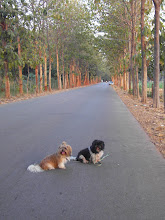Ancient Thai Beliefs
Beliefs begin from feeling and thought of each society, because each society has different cultures. Some beliefs may have the right reason but some belief doesn’t. It’s depend on beliefs of each person, in the same social doesn’t mean everyone believe in the same things. But we would like to present beliefs of Thai ancient which most people believe.
Beliefs of Thai ancient have on many things. Beliefs are starting point of cultures and traditions of Thai society at present. Many events happens and the last event is same as the forecast of beliefs of Thai ancient.
Beliefs below are examples of beliefs of Thai ancients which about lucky, unlucky, and foretell about future that will appear. They explain by phenomena and environment around them. Examples of beliefs of Thai ancient are;
1. Bees make their hives in your house that means you will be lucky.
In natural, bees always make their hives on the big trees and live in peaceful places, but when they are making their hives under your house roof or in your house that means they will give good luck. If they make a big hive, you will get more good luck. Because Thai ancient believe bees are good luck animals.
2. Don’t wear black clothes when visit patients. 
Thai ancient believe black clothes are mean sorriness. They wear black clothes only in the funeral. If you wear black clothes when go to visit patients that mean you are cursing them. You should wearing colorful or polite color clothes and make cheerful face for give their morale.
3. Smell joss stick means manes
In silence place, if you smell joss sticks although nobody light up them. It means the manes of dead people in your family is being around you. If this situation had happened to you, you’d light up one joss stick and say something like “I’m fine, don’t worry anymore”…
4. Don’t get your hair cut on Wednesday
Thai ancients believe that getting your hair cut on Wednesday is very bad luck. If you come to Thailand and notice, you’ll see that most of barbershops are closed on Wednesday.
If you get your hair cut on Sunday, you would have long life.
If you get your hair cut on Monday, you would get good luck.
If you get your hair cut on Tuesday, you would get attack from enemy.
If you get your hair cut on Wednesday, you would easy to quarrel with others.
If you get your hair cut on Thursday, you would get protection from angels.
If you get your hair cut on Friday, you would get good luck.
If you get your hair cut on Saturday, you would succeed in everything.
5. Hand hitting with the others while eating food means somebody is coming.
In the past, Thai people didn’t have telephone or anything to contact each other. So that, Thai people believe that while eating food together, if someone’s hands hit with the others by accident, it means somebody is coming to your house. So, the next day they will prepare food for welcoming guest. And the situation like this always be true.
 6. Lizard greet, don’t go out.
6. Lizard greet, don’t go out.
Thai ancients believe that if you heard the lizard in your house cry behind you or up on your head that means bad luck. You’ll get the accidents. So, you should postpone your work and go out later.
7. Comb broken means bad things will happen.
Thai ancients believe that if your comb is broken while you are brushing your hair it means bad things will happen to you. You may argue over the others or you may lose something you love. Let’s throw away that comb!
8. Don’t broom the floor at night!
Thai people believe that if you broom the floor at night, it means you broom your money and your property away.
 9. Don’t give handkerchief for gifts.
9. Don’t give handkerchief for gifts.
Thai people believe that giving handkerchief means farewell.
Because when we say good bye to someone, we use handkerchief to wipe tears.
 10. Don’t buy shoes for your lover.
10. Don’t buy shoes for your lover.
Thai people believe that giving shoes to lover means she or he will walk away from you.
11. Sharp pencil with the bright brain.
Thai people believe that putting sharp pencil in the glass and put them right on your worktable will make your brain brighter.
These are many beliefs of Thai ancients. Some of them can be true if you believe. It depends on you if you believe you may know about what will be happen in the future. For us, we believe on them and they come true in sometimes.
Post by
SUPUNSA MEEBOON 513081066-4
NARISA KUMSUWAN 513080700-1

 at Phra Phutthachinnarat hospital in Phitsanulok. She was just 31 years of age. At her funeral at Wat Tapkradan in Suphanburi province, an estimated 200,000 people turned up to pay their last respects. Even HM The King attended. Her voice and songs remains outstanding and the frequency with which her songs are still played, one and a half decade after her death,suggest that she will be remembered far beyond any foreseeable future.
at Phra Phutthachinnarat hospital in Phitsanulok. She was just 31 years of age. At her funeral at Wat Tapkradan in Suphanburi province, an estimated 200,000 people turned up to pay their last respects. Even HM The King attended. Her voice and songs remains outstanding and the frequency with which her songs are still played, one and a half decade after her death,suggest that she will be remembered far beyond any foreseeable future.





















